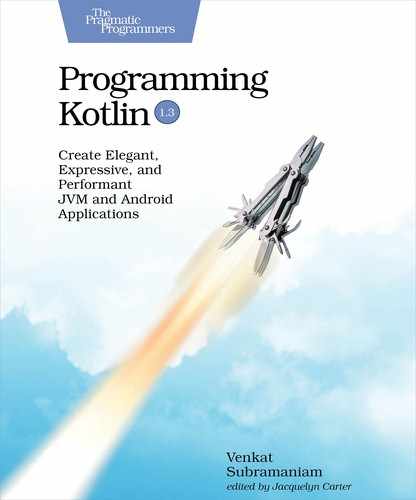Integrating the Service with Controller
It’s time to modify the TaskController we wrote earlier, to add two new methods and to modify the existing tasks() method—that is, the GET operation.
Once again, if we were to write in Java, here’s what the modified controller would look like:
| | //Java code only for comparison purpose |
| | package com.agiledeveloper.todo; |
| | |
| | import org.springframework.stereotype.Controller; |
| | import org.springframework.web.bind.annotation.*; |
| | import org.springframework.http.ResponseEntity; |
| | |
| | @RestController |
| | @RequestMapping("/task") |
| | class TaskController { |
| | |
| | private final TaskService service; |
| | |
| | public TaskController(TaskService service) { |
| | this.service = service; |
| | } |
| | |
| | @GetMapping |
| | ResponseEntity<Iterable<Task>> tasks() { |
| | return ResponseEntity.ok(service.getAll()); |
| | } |
| | |
| | @PostMapping |
| | ResponseEntity<String> create(@RequestBody Task task) { |
| | Task result = service.save(task); |
| | |
| | return ResponseEntity.ok( |
| | "added task with description " + result.getDescription()); |
| | } |
| | |
| | @DeleteMapping("/{id}") |
| | ResponseEntity<String> delete(@PathVariable Long id) { |
| | if (service.delete(id)) { |
| | return ResponseEntity.ok("Task with id " + id + " deleted"); |
| | } |
| | |
| | return ResponseEntity.status(404) |
| | .body("Task with id " + id + " not found"); |
| | } |
| | |
| | |
| | } |
Let’s change the Kotlin version of the TaskController to add the necessary operations:
| | package com.agiledeveloper.todo |
| | |
| | import org.springframework.web.bind.annotation.* |
| | import org.springframework.http.ResponseEntity |
| | |
| | @RestController |
| | @RequestMapping("/task") |
| | class TaskController(val service: TaskService) { |
| | |
| | @GetMapping |
| | fun tasks() = ResponseEntity.ok(service.getAll()) |
| | |
| | @PostMapping |
| | fun create(@RequestBody task: Task): ResponseEntity<String> { |
| | val result = service.save(task) |
| | |
| | return ResponseEntity.ok( |
| | "added task with description ${result.description}") |
| | } |
| | |
| | @DeleteMapping("/{id}") |
| | fun delete(@PathVariable id: Long) = if (service.delete(id)) { |
| | ResponseEntity.ok("Task with id $id deleted") |
| | } else { |
| | ResponseEntity.status(404).body("Task with id $id not found") |
| | } |
| | |
| | } |
First, we modified the class to add a property service of type TaskService. Spring will automatically inject a reference to that dependency when the instance of TaskController is created. Next, we modified the tasks() method to return the result of the getAll() method of the service. We also added two more methods, create() and delete().
The create() method has been annotated to specify that it supports the POST HTTP method, and it accepts a Task as post data through the body of the incoming request. The method invokes the service’s save() method to save the given object to the database.
The delete() method supports the DELETE HTTP method and the annotation also specifies that the request should include the id of the task to be deleted. The method forwards the request to the service’s delete() method and returns an appropriate HTTP response.
